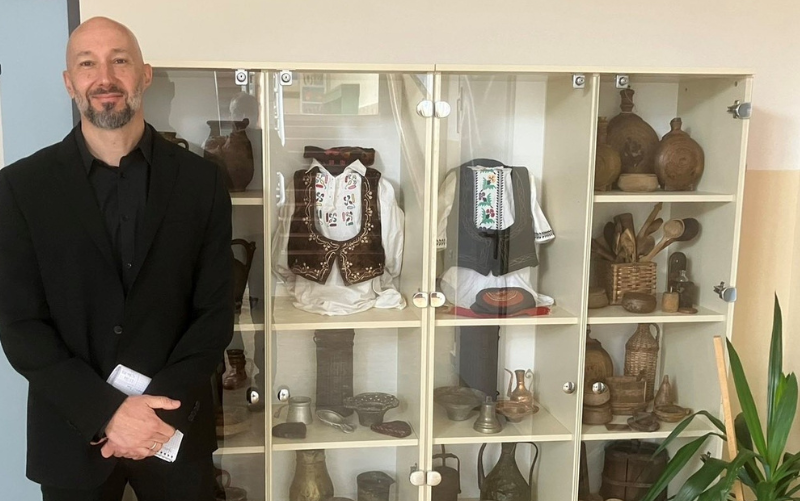-
QUALIFICATIONS
- For Linguists Worldwide
- For UK Public Services
- Preparation
- Policies & Regulation
-
MEMBERSHIP
- Join CIOL
- Membership grades
- NEW for Language Lovers
- Chartered Linguist
- Already a member?
- Professional conduct
- Business & Corporate Partners
-
ASSESSMENTS
- For Second Language Speakers
- English as a Second Language
-
EVENTS & TRAINING
- CPD, Webinars & Training
- CIOL Conference Season 2025
- Events & Networks
- CIOL Mentoring
-
NEWS & VOICES
- News & Voices
- CIOL eNews
- CIOL Awards
- The Linguist
- Jobs & Ads
-
RESOURCES
- For Translators & Interpreters
- For Universities & Students
- Standards & Norms
- CIOL & AI
- All Party Parliamentary Group
- In the UK
- UK Public Services
- Find-a-Linguist
Challenges in implementing gender sensitivity in the Serbian language

Translator and interpreter Andreja Milošević with display cabinet showing traditional Serbian artefacts produced by vulnerable groups
Gender Sensitive Language
Serbia adopted its first National Strategy for Improving the Position of Women and Promoting Gender Equality in 2009 (Stevanovic, 2023). It took ten more years before the Gender Sensitive Language Implementation Guide was published in 2019 (TSI, 2019). The publication was a joint effort of Serbian government’s Gender Equality Coordination Body and UN Women and was the first comprehensive document to discuss practical implications of gender sensitivity in the Serbian language (ibid). The 146-page document outlined the necessity to make Serbian a differentiated, sensitive and non-discriminatory language, highlighted the correlation between gender and grammar, politics and discrimination, noted some of the common misconceptions and provided a glossary (Cveticanin Knezevic and Lalatovic, 2019).
Following on from this, OEBS assisted in drafting the Guide for the Implementation of Gender Sensitive Language in Public Administration in 2020 (OEBS, 2020).
In 2021, Serbian Government adopted the Law on Gender Equality, stipulating inter alia the introduction of gender sensitive language in the media, educational institutions, academia and publications three years after the adoption of the Law (Kljajic, 2024). The lead time saw a fierce political and academic debate largely focused on gender sensitive language, and the use of social feminitives in particular (Petrovic, 2002). Notwithstanding the ongoing dispute, the adoption of additional clauses to the Law that confirmed mandatory use of gender sensitive language went ahead in May 2024 (Kljajic, 2024).
However, just one month later the Constitutional Court of Serbia temporarily revoked the Law on Gender Equality and ordered evaluation of its constitutionality (Constitutional Court, 2024).
So what is the controversy?
Unlike English, all nouns in Serbian have a gender – masculine, feminine and neuter – which are grammatical, rather than natural (determined by their ending, not their meaning) (Stevanovic, 2023). In an environment where women were historically not practising many occupations, many of the nouns describing such occupations only have the male form (ibid). The required changes to make the language more gender sensitive were managed by adding various suffixes to male forms of occupations – i.e. feminitives (ibid). It is the addition of several hundred feminitives to the Serbian language that sparked the dispute between the conservative and the progressive fractions in linguistic, political and religious circles (Petrovic, 2022).
What is the damage from not furthering gender sensitisation of the Serbian language?
Firstly, gender sensitive language increases visibility of vulnerable groups and emphasises their equality – and lack thereof can significantly deter gender mainstreaming in the broader sense (Petrovic, 2022). Secondly, gender sensitive language is important for improving the position of women and acknowledging their status by the introduction of feminitives in the naming conventions for their qualifications, roles and job descriptions (Petrovic, 2022). Thirdly, insisting on preserving the male gender as the linguistic standard only feeds the patriarchal pattern that perceives men as the subject and an active linguistic factor and women as an object and a passive factor, which then translates to other spheres of life (Paragraf Lex, 2024). This is particularly striking if language is considered a manifest of social reality in a changing environment where an increasing number of women are taking up leading (and previously male-dominant) positions (Georgijev, 2014).
Quite literally, the jury is still out on this one and the progress of gender sensitivity in the Serbian language is on hold.
Andreja Milošević MCIL is a Serbian translator and interpreter, and is a member of CIOL's ED&I Committee.
Views expressed on CIOL Voices are those of the writer and may not represent those of the wider membership or CIOL.
Further Resources:
Constitutional Court of the Republic of Serbia (2024) Saopstenje sa 8. Sednice Ustavnog suda, odrzane 27. Juna 2024. Godine. Constitutional Court of the Republic of Serbia [online]. Available at: Саопштење са 8. седнице Уставног суда, одржане 27. јуна 2024. године, којом је председавала Снежана Марковић, председница Уставног суда - Саопштења са седнице Уставног суда (sud.rs). [Accessed 10 October 2024].
Cveticanin Knezevic, H. and Lalatovic, J. (2019) Prirucnik za upotrebu rodno osetljivog jezika. Government of the Republic of Serbia [online]. Available at: Приручник за употребу родно осетљивог језика_ћирилица_0.pdf (rodnaravnopravnost.gov.rs). [Accessed 10 October 2024].
Georgijev, I. (2014) Communities of Practice and Linguistic Change: Perception of Gender-sensitive Language in Serbian Literary Translation. Knjizenstvo [online]. Available at: http://www.knjizenstvo.rs/en/journals/2014/womens-writing-and-culture/communities-of-practice-and-linguistic-change-perception-of-gender-sensitive-language-in-serbian-literary-translation#gsc.tab=0. [Accessed 11 October 2024].
Government of Serbia Social Inclusion and Poverty Reduction Unit (TSI)(2019) Predstavljen prirucnik za upotrebu rodno osetljivog jezika. Tim za socijalno ukljucivanje i smanjenje siromastva [online]. Available at: Представљен Приручник за употребу родно осетљивог језика : Инклузија (socijalnoukljucivanje.gov.rs). [Accessed 10 October 2024].
Kljajic, K. (2024) Srpski jezik: Gde se i kako koriste rodno osetljive reci. BBC News in Serbian [online]. Available at: https://www.bbc.com/serbian/lat/srbija-69042284. [Accessed 10 October 2024].
OEBS (2020) Vodic za upotrebu rodno osetljivog jezika u javnoj upravi u Srbiji. Organization for Security and Co-operation in Europe [online]. Available at: Vodič za upotrebu rodno osetljivog jezika u javnoj upravi u Srbiji | OSCE. [Accessed 10 October 2024].
Paragraf Lex (2024) Zakon o rodnoj ravnopravnosti: Upotreba rodno osetljivog jezika. Paragraf Lex [online]. Available at: ZAKON O RODNOJ RAVNOPRAVNOSTI: Upotreba rodno osetljivog jezika je predviđena u oblasti obrazovanja, vaspitanja, nauke i tehnološkog razvoja, između ostalog, u udžbenicima, nastavnom materijalu, u svedočanstvima, diplomama, klasifikacijama, zvanjima, zanimanjima (paragraf.rs). [Accessed 10 October 2024].
Petrovic, T. (2022) Gender-sensitive language use in Serbia: between linguistic nationalism and box-checking performance. Gender & Language 16(3), pp.216-240.
Stevanovic, M. (2023) Gender-Sensitive Language in Textbooks: Examples of Good Practice. Reci, Journal of Language, Literature and Culture 16(23) [online]. Available at: GENDER-SENSITIVE LANGUAGE IN TEXTBOOKS: EXAMPLES OF GOOD PRACTICE | Reči (reci.rs). [Accessed 11 October 2024].
More
The Chartered Institute of Linguists (CIOL), Incorporated by Royal Charter, Registered in England and Wales Number RC 000808 and the IoL Educational Trust (IoLET), trading as CIOL Qualifications, Company limited by Guarantee, Registered in England and Wales Number 04297497 and Registered Charity Number 1090263. CIOL is a not-for-profit organisation.







